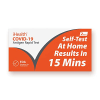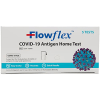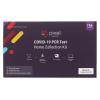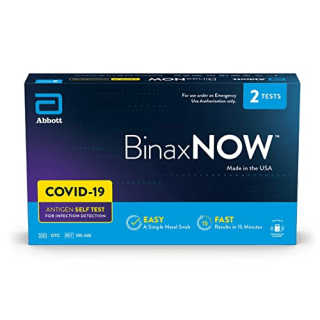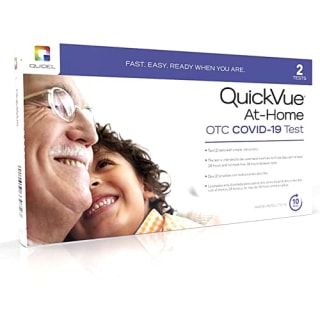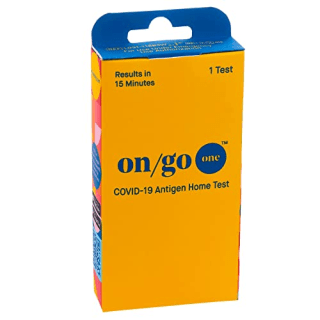Gone are the days of visiting a doctor’s office to determine whether you have Covid. Instead, you can buy over-the-counter test kits, which diagnose infection from the comfort of your home, making them convenient. However, at-home Covid tests are generally less sensitive than tests performed by medical professionals, so it’s important to understand their benefits and limitations, says Omai Garner, PhD, chief of clinical microbiology for the UCLA Health System.
I spoke to experts about how to shop for at-home Covid tests, including how they work, who should use them and how accurate they are. I also rounded up FDA-authorized test kits you can purchase right now.
SKIP AHEAD FDA-authorized at-home Covid tests to shop | Home collection v.s. rapid tests | Tips for using at-home tests | Why trust NBC Select?
Want more from NBC Select? Sign up for our newsletter, The Selection, and shop smarter.
What to know about at-home Covid tests before shopping
There are two methods of at-home testing:
- Home collection tests: The test kit prompts you to collect a sample at home (a nose or throat swab) and send it to a lab. The lab then performs a Polymerase Chain Reaction (PCR) test on the sample, which is the best and most accurate type of diagnostic Covid test, and considered the “gold standard,” says Garner. You get your results online in a few days.
- Rapid tests: The test kit prompts you to collect a sample at home (a nose or throat swab) and you perform the test using provided materials. You get results in a few minutes, which is why these tests are often called “rapid tests.” You also may see rapid tests called self-tests, according to the CDC.
Both methods of at-home testing allow you to do diagnostic tests, which tell you if you’re actively infected with Covid. Diagnostic Covid tests fall into two buckets: molecular tests and antigen tests. The tests detect different parts of the Covid virus and vary in sensitivity.
- Molecular tests are more sensitive, meaning they require a lower amount of virus in a sample to detect a positive result. PCR tests are molecular tests.
- Antigen tests are less sensitive, meaning they require a higher amount of virus in a sample to detect a positive result.
It’s important to note that most rapid tests are antigen tests, and while a few molecular rapid tests are available, they are not PCR tests — they perform a different type of molecular test that’s less sensitive, which means they require a higher amount of the virus in a sample to detect it, says Garner. Be aware that many rapid test kits say they are able to deliver PCR-quality results, but a PCR-quality test is not equivalent to a PCR test, says Garner.
How I picked the best at-home Covid tests
While shopping for at-home Covid tests, experts recommend considering the following:
- FDA authorization: Experts say you should only buy at-home Covid tests that received FDA authorization, which should be noted somewhere on the product’s packaging. To double check authorization status and learn more about which models have been authorized, you can browse a list available on the FDA’s website — it’s separated by antigen and molecular diagnostic tests.
- Type: When deciding between buying a home collection or rapid test, think about how quickly you’ll need results. With home collection tests, you’ll have to wait a few days to get results. But as their name implies, you’ll get results in minutes from rapid tests. However, since they tend to be less sensitive than home collection tests, it’s advised that you serial test with rapid tests, which means that you perform a second test a few days after your first (more on serial testing below).
- Age: All Covid tests list minimum age restrictions, if there are any, on their packaging, which is especially important if you plan to use a kit with a child.
- Result delivery: With home collection tests, you’ll have to send a sample to a lab, which delivers your results via email and/or through an online portal or app. You can interpret the results of most rapid tests on the included test card, but some require a companion app, and others require an electronic reader or analyzer, which tend to be pricier. Be sure to read about how you’ll get the results before stocking up on Covid tests.
The best FDA-authorized at-home Covid tests to shop
Below are some of the most widely available Covid home testing kits on the FDA-authorized list. All of the rapid tests require you to collect a nasal or saliva swab and perform the test yourself using provided materials. All of the home collection tests come with prepaid return labels and professionals perform PCR tests on your samples when they arrive at the labs.
One of the most important things to know about rapid tests is that they often come with two or more tests and recommend that you perform multiple tests a few days apart — this is called serial testing, according to the CDC. The FDA recommends repeat (serial) testing following a negative result from an at-home antigen test whether or not you have symptoms. This is because on the first day you perform an at-home test, it might not be able to detect low levels of the virus and you may get a false negative, even if you’re symptomatic, says Dr. Sharon Nachman, chief of the division chief of pediatric infectious diseases at Stony Brook Children’s Hospital.
iHealth COVID-19 Antigen Rapid Test
iHealth’s kit includes two tests — it’s best to test twice over three days with 24 to 48 hours between them, according to the brand. You perform the test using a nasal swab you collect, a test card and processing fluid. iHealth also offers an app you can download to log your results.
Type: rapid | Result time: 15 minutes | Age range: 2 years old and above | Sample type: nasal
BinaxNOW COVID-19 Antigen Self Test
This kit comes with two tests — you should test yourself twice within three days, making sure tests are done at least 36 hours apart, according to the brand. It provides the materials needed to perform nasal swabs as well as the actual test, which is done using test cards and processing fluid.
Type: rapid | Result time: 15 minutes | Age range: 2 years old and above | Sample type: nasal
FlowFlex COVID-19 Antigen Home Test
FlowFlex’s home testing kit comes with five tests. After the first test, the brand recommends testing two more times at least 48 hours apart. The kit comes with materials needed to perform a nasal swab and the actual test, which is done using a test card and processing fluid.
Type: rapid | Result time: 15 minutes | Age range: 2 years old and above | Sample type: nasal
Quidel QuickVue At-Home COVID-19 Antigen Test Kit
This kit is intended for you to test twice over two to three days with 24 to 36 hours between each test. You collect a nasal swab sample and dip it into a solution tube with a test strip to perform the test.
Type: rapid | Result time: 10 minutes | Age range: 2 years old and above | Sample type: nasal
On/Go COVID-19 Antigen Self-Test
On/Go’s kit comes with one test, so you'll have to buy multiple to perform serial testing. You should test twice over two or three days with 24 to 48 hours between them, according to the brand. There is a QR code on the box you can scan to download a companion app, which guides you through the testing process and allows you to log your test results. The test comes with materials needed to perform a nasal swab and the actual test, which is done using test cards and processing fluid.
Type: rapid | Result time: 10 minutes | Age range: 2 years old and above | Sample type: nasal
Pixel by Labcorp COVID-19 PCR Test Home Collection Kit
This home collection test comes with all the materials you need to collect a nasal swab, which you ship to the brand's lab using the included pre-paid return label. The lab runs a PCR test on your sample and posts your results online about one or two days after it arrives.
Type: home collection | Result time: 24 to 48 hours after the sample arrives at the lab | Age range: 2 years old and above | Sample type: nasal
Home collection tests versus rapid tests: Pros and cons
The two at-home Covid testing methods — home collection kits and rapid tests — are similar in that they can diagnose infection and are performed on either nose or throat swabs. From there, the methods differ, and experts say those differences determine how reliable tests are, as well as how you should use them. I broke both testing methods down and highlighted pros and cons to be aware of.
Home collection tests
Pros: Home collection tests generally produce more accurate results than rapid tests. “The reason for that is because the gold standard PCR test is run on the sample, and the people running the test are professionals,” says Garner.
Cons: You need to account for human error. Because you are collecting the sample instead of a trained professional, there’s always the possibility of collecting a poor sample, which can impact your result, says Garner.
Rapid tests
Pros: Rapid tests deliver results in minutes, so if you are symptomatic, you can learn if what you’re experiencing is Covid or not very quickly.
Cons: Some rapid tests say they can screen asymptomatic individuals for Covid. However, Garner says he “fundamentally disagrees with [this]” because you cannot perform a PCR test — the most accurate Covid test — entirely at home. If you test too early with a rapid test, there may only be low levels of the virus present in the sample, which could lead to an inaccurate result. Thus, Garner does not think rapid tests are appropriate for asymptomatic testing, and all the experts we interviewed agreed. As for symptomatic testing, he says rapid tests perform relatively well — there is typically a higher amount of virus present in the body, reaching a threshold rapid tests can cover, he says.
Tips for using at-home Covid tests
Each test kit is different and requires its own specific set of procedures, so it’s crucial to read the directions before taking a sample, says Nachman. "It sounds silly to say, but reading the directions carefully is actually quite critical to do,” she says.
When you get your results from home collection or rapid tests, they’re simply reported to you, not explained, says Nachman. Because of this, it’s important to call your primary care doctor — especially if you test positive — to understand how to proceed. “At-home tests are geared to get the information to you with the idea that you’re going to call for a helping hand to deal with the results, particularly if there’s a positive result,” she says.
Meet our experts
At NBC Select, we work with experts who have specialized knowledge and authority based on relevant training and/or experience. We also take steps to ensure that all expert advice and recommendations are made independently and with no undisclosed financial conflicts of interest.
- Dr. Omai Garner, PhD, is the chief of clinical microbiology for the UCLA Health System and an associate clinical professor of pathology and laboratory medicine.
- Dr. Sharon Nachman is chief of the division chief of pediatric infectious diseases at Stony Brook Children’s Hospital and a professor of pediatrics at Stony Brook’s Renaissance School of Medicine.
Why trust NBC Select?
I'm a reporter at NBC Select who has covered Covid since 2020. In addition to at-home Covid tests, I've reported about disposable masks, KN95 masks, N95 masks, KN95 masks for kids and vaccine card holders. For this article, I spoke to two experts about how to shop for and use at-home Covid tests.
Catch up on NBC Select’s in-depth coverage of tech and tools, wellness and more, and follow us on Facebook, Instagram, Twitter and TikTok to stay up to date.

